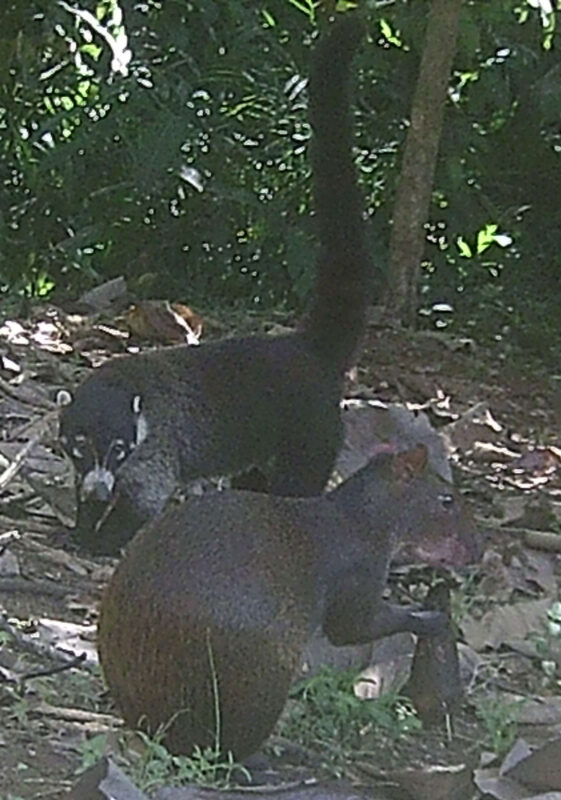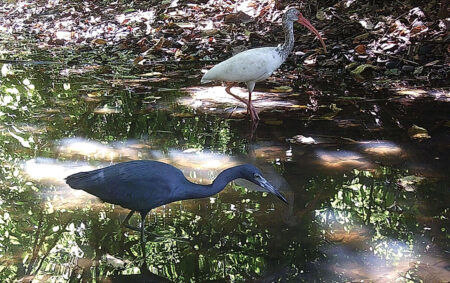Strange Buddies – Relationships Between Different Species
Relationships Between Different Species
 The big male coati was walking across a grassy area behind our house, toward the swampy forest around half a football field from our back porch. Out of the corner of my eye, I caught sight of a collared peccary walking parallel to the jungle on a collision course with the coati. “This is going to be interesting”, I thought. But nothing exciting happened. The coati continued at the same pace as did the peccary. The coati passed in front about an arm’s length from the nose and tusks of the larger pig-like mammal. Neither paid the least bit of attention to the other, didn’t even turn their heads to glance at one another. The coati ambled on into the jungle and the peccary continued its walk along the edge without altering its path. I had thought the coati would take off and rush into the thick forested area rather than risk an encounter with the much larger peccary. I mulled over the strange happening I had just witnessed. “Maybe they know each other. I see that same coati every day. I can tell it’s him by the scar on his left cheek, and I have seen plenty of collared peccary in that area. Is it ridiculous to think that they are friends? At the very least, they know each other and are friendly neighbors”.
The big male coati was walking across a grassy area behind our house, toward the swampy forest around half a football field from our back porch. Out of the corner of my eye, I caught sight of a collared peccary walking parallel to the jungle on a collision course with the coati. “This is going to be interesting”, I thought. But nothing exciting happened. The coati continued at the same pace as did the peccary. The coati passed in front about an arm’s length from the nose and tusks of the larger pig-like mammal. Neither paid the least bit of attention to the other, didn’t even turn their heads to glance at one another. The coati ambled on into the jungle and the peccary continued its walk along the edge without altering its path. I had thought the coati would take off and rush into the thick forested area rather than risk an encounter with the much larger peccary. I mulled over the strange happening I had just witnessed. “Maybe they know each other. I see that same coati every day. I can tell it’s him by the scar on his left cheek, and I have seen plenty of collared peccary in that area. Is it ridiculous to think that they are friends? At the very least, they know each other and are friendly neighbors”.
 About a week later I was out for an afternoon walk and encountered a band of coatis, females with young. These groups tend to walk around with their tails straight up and bent backward at the top. The low-lying vegetation pretty much covered their bodies, and all I could see were the tails moving around through the broad-leaf plants. After watching for a few minutes, I continued my walk. I hadn’t taken five steps when I noticed something strange. Some of the tails moved around like the others, but rather than being bent back at the top, they were curled toward the front. The two groups of tails weren’t mixed. There was a well-defined line between them. After a few seconds, I remembered a troop of capuchin monkeys I had been watching before I noticed the coatis. They had been playing in the treetops earlier, but obviously had come to the ground and were now side by side with the coatis. White-throated capuchin monkeys prey on small coatis that haven’t yet left their nests, but these young coatis with their mothers were nearly full-grown, and any monkey that tried to harm one would have to deal with a bunch of very pissed adult female coatis weighing half again as much as the monkeys. So, I guess they decided to be friends or at least friendly neighbors. “Hmmm”, I thought. This is the second time this week that I have seen two species near each other.
About a week later I was out for an afternoon walk and encountered a band of coatis, females with young. These groups tend to walk around with their tails straight up and bent backward at the top. The low-lying vegetation pretty much covered their bodies, and all I could see were the tails moving around through the broad-leaf plants. After watching for a few minutes, I continued my walk. I hadn’t taken five steps when I noticed something strange. Some of the tails moved around like the others, but rather than being bent back at the top, they were curled toward the front. The two groups of tails weren’t mixed. There was a well-defined line between them. After a few seconds, I remembered a troop of capuchin monkeys I had been watching before I noticed the coatis. They had been playing in the treetops earlier, but obviously had come to the ground and were now side by side with the coatis. White-throated capuchin monkeys prey on small coatis that haven’t yet left their nests, but these young coatis with their mothers were nearly full-grown, and any monkey that tried to harm one would have to deal with a bunch of very pissed adult female coatis weighing half again as much as the monkeys. So, I guess they decided to be friends or at least friendly neighbors. “Hmmm”, I thought. This is the second time this week that I have seen two species near each other.
 In this article, I mention coatis more than other species, but I have photos of mammals with birds, birds of different species, and one video with three species, an agouti, a gray-necked wood-rail, and a neotropical river otter all hanging out around a big mud puddle during the dry season. Much of this type of behavior may take place in areas where the animals have not experienced violence from humans. There is no way of knowing for sure, but it seems likely that when the animals, birds, and reptiles have no fear of humans, they will feel more at ease with their closest neighbors.
In this article, I mention coatis more than other species, but I have photos of mammals with birds, birds of different species, and one video with three species, an agouti, a gray-necked wood-rail, and a neotropical river otter all hanging out around a big mud puddle during the dry season. Much of this type of behavior may take place in areas where the animals have not experienced violence from humans. There is no way of knowing for sure, but it seems likely that when the animals, birds, and reptiles have no fear of humans, they will feel more at ease with their closest neighbors.
A couple of months ago, one of my trail cameras captured a photo of a male coati and an agouti within a meter of each other. The agouti was totally ignoring its nearby companion. The coati was looking at the agouti as if to say, “Boy, what a stuck-up little so-and-so. He won’t even say ‘Hi’”. I posted the photo on Facebook, and a friend of mine who has plenty of expertise with trail cameras commented that in the last two months, he has captured more photos with more than one species in the same photo than ever before. Interestingly, both he and I have our cameras in areas that are protected from illegal hunting.
If this is a trend of Mother Nature’s, let’s hope humanity is included. We humans may be able to learn something beneficial for our own species by observing the behavior of our wild friends.
Jack Ewing was born and educated in Colorado. In 1970 he and his wife Diane moved to the jungles of Costa Rica where they raised two children, Natalie and Chris. A newfound fascination with the rainforest was responsible for his transformation from cattle rancher into environmentalist and naturalist. His many years of living in the rainforest have rendered a multitude of personal experiences, many of which are recounted in his published collection of essays, Monkeys are Made of Chocolate. His latest book is, Where Jaguars & Tapirs Once Roamed: Ever-evolving Costa Rica.

